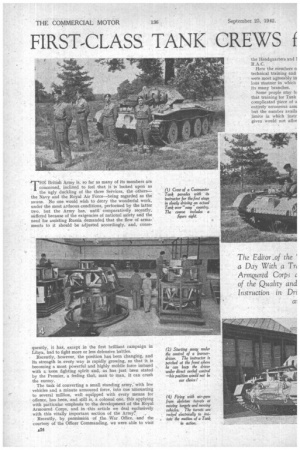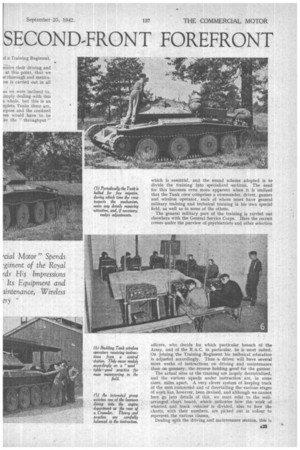FIRST-CLASS TANK CREWS f SECOND-FRONT FOREFRONT
Page 26

Page 27

Page 28

Page 31

If you've noticed an error in this article please click here to report it so we can fix it.
THE British Army is, so far as many of its members are concerned, inclined to feel that it is looked upon as the ugly duckling of the three Services, the others— the Navy and the Royal Air Force—being regarded as the swans. No one would wish to decry the wonderful work, under the most arduous conditions, performed by the latter two, but the Army has, until comparatively recently, suffered because of the exigencies of national safety and the need for assisting Russia demanded that the flow of armaments to it should be adjusted accordingly, and, conse
quently, it has, except in the first brilliant campaign in Libya, had to fight more or less defensive battles.
Recently, however, the position has been changing, and its strength in every way is rapidly growing, so that it is becoming a most powerful and highly mobile force imbued with a keen fighting spirit and, as has just been stated by the Premier, a feeling that, man to man, it can crush the enemy.
The task of converting a small standing army,' with few vehicles and a minute armoured force, into one amounting to several million, well equipped with every means for offence, has been, and still is, a colossal one, this applying with particular emphasis to the development of the Royal Armoured Corps, and in this article we deal exclusively
with this vitally important section of the Army.' , Recently, by permission of the War Office, and the courtesy of the Officer Commanding, we were. able to visit the Headquarters and R .A .C.
Here the members o technical training and were most agreeably in bons manner in which its many branches.
Some people nay in that training for Tank complicated piece of a entirely erroneous assu but the number availa limits in which instr given would not affor
A a Training Regiment,
E.ceive their driving and at this point, that we te thorough and meticuon is carried out in all as we were inclined to, amply dealing with this a whole, but this is an nplete Tanks there are, irpose and the confined ese would have to be ke the " throughput " which is essential, and the sound scheme adopted is to divide the training into specialized sections. The need for this becomes even more apparent when it is realized that the Tank crew comprises a commander, driver, gunner and wireless operator, each of whom must have general military training and technical training in his own special field, as well as in some of the others.
The general military part of the training is carried out elsewhere with the General Service Corps. Here the recruit comes under the purview of psychiatrists and other selection officers, who decide for which particular branch of the Army, and of the R.A.C. in particular, he is most suited. On joining the Training Regiment his technical education is adjusted accordingly. Thus a driver will have several more weeks of instructions on driving and maintenance than on gunnery, the reverse holding good for the gunner.
The actual sites of the training are largely decentralized, and the various squads under instruction are, in some cases, miles apart. A very clever system of keeping track of the men concerned and of dovetailing the various stages of work has, however, been devised, and although we cannot here go into details of this, we must refer to the wellarranged chart board, which indicates how the work of wheeled, and track vehicles is divided, also to how the charts, with their numbers, are picked out in colour to represent the various classes.
Dealing with the driving and maintenance section, this is practically a technical college, and at the beginnirpg of Our tour of this, we were immediately impressed by the model room, which contains such useful instructional Niaterial as actual Tank and other units, many partially sectioned to show the internal construction. There are large and small engines, differentials, clutches, electrical equipment, and in another room, a complete Tank engine,
In the lecture rooms there are printed and coloured diagrams, blackboards upon which the instructors deal
graphically with knotty points an these machines, a wellequipped laboratory with circuit diagrams and actual components, together with a cinema where appropriate films are displayed.
What is known as the Highway-Code room contains a large model representative of a typical stretch of country. with roads, hills, roundabouts, bridges, etc., on which, by
the aid of miniature vehicles, the instructor can indicate the correct, procedure to be adopted in various circumstances. At points in the many rooms are displayed posters which, in picture or words, or both, give safR-driving and other hints.
The trainees start from first principles, on a singlecylindered engine, and work up to dismantling and reassembling a complete Tank. A certain number of tradesmen is also given specialized courses, and there is a despatch riders' section.
Driving is taught first on wheeled vehicles, then, on carriers with tracks, and. finally, on Tanks. proper. There is a fairly flat elementary route, on which the learner has to do a figure
eight lap, following which he proceeds to a more advanced cross-country section, and then to driving on „quiet roads, including passing through a village, so that he wilq become accustomed to avoiding kerbstones, etc. Every driver thus receives a considerable number of hours in actual control of a modern Tank, which, incidentally, includes periods
of driving by night.
Throughout the training there is a very satisfactory combination of theory and practice. Thus a man is shown, say, a particular component on a graph, and is then taken to the actual machine and shown its relative position. and the attention which it requires.
As it is important to conserve the training machines, a strict driving and maintenance routine is taught and is carried out in practice. Before being moved, a Tank is warmed up for the required period, oil levels checked, temperature gauge read, and the dualignition systems tried separately. Periodical check halts are made, when the crew lift the engine covers and make a short general investigation. 'During the last period, dirt: and surplus grease are cleaned off, nuts are tightened, and, in fact, the machine is made ready for its wOrk next day. • One of the most important branches of the work in a Tank is the sending and reception of messages by wireless, and the training in this connection is just as thorough as in the mechanical field: in the same way as in the latter case, it is mostly carried out indoors, and divided into various classes. • One large bay is devoted to fault-finding, another has what is termed a sand table, around which gathers a number of men, each with his wireless set and ear phones, and according to the instructions he receives from the sending station he moves miniature Tanks over the table.
The gunnery school proved exceptionally interesting. Ih one part is a miniature range equipped with turrets conforming in their interior economy with the space available within the Tanks they represent. These turrets are rocked by electric power to simulate the movement of a Tank, and can also rotate by power.
To save a great expenditure of ammunition v‘hich would otherwise be incurred, their armament is represented by air guns; these the learners can fire to their hearts' content at revolving targets, and at miniature Tanks which run about on a stretch of imitation desert. These models are also moved in any desired direction by electric means. Much use is also made of panoramic effects. In one, the pressing of various buttons causes electric sparks to occur at choice at various points; for example, there is a tiny ruined house, and sparks in a window indicate the fire of a machine gun. The Tank gunners sight on the target thus afforded, and the correctness or otherwise of their aim is indicated electrically.
On a much bigger scale, is a circular panorama surrounding a Tank turret. Between the turret and the view is a converted machine gun, pressing the trigger of which throws a. minute spot of light on to any desired point. The light is shown momentarily, and the gunner has to fix the position in his mind, swing around and get on to the target thus given. As he " fires," a splash of light appears, and the distance of this from the point where the spot showed represents the error. If the machine gun be not moved, it can repeat this..display of the spot, so that no argument is possible. Both here and on the outer range we saw a number of Polish officers under instruction, and very keen they appeared to be.
Part of the gunnery course is concerned with protection and (offence against aircraft. Consequently, it includes aeroplane-recognition tests, also a most realistic arrangement by which a neophyte gunner is stationed at the corner of a room, whilst towards him swoop models of various types of aeroplane in such a mLiner as to represent ordinary diving, hedge-hopping, etc. Models are also shown behind a fabric screen with a tight behind, so that they appear in silhouette. Recognition is also taught in relation to Tanks of all classes and countries, the models being mounted on shelves, and each having a handle underneath, so that it can be turned without touching the model.
The gunnery wing has its own cinema, also an epidiascope, the latter permitting excellent vieWs of small opaque objects to be projected. Other open-cage turrets face a real piece of panoramic country, and here practice in sighting is performed. By chance, various classes of aircraft are constantly flying in the vicinity, and the gunners get plenty of opportunity of aiming at these, so that they learn quickly to control their turrets and get on to the target .without delay.
From these classes they proceed to stationary Tanks, to become even more accustome& to the controls, etc. Then they run into the country on tne Tanks, and soon proceed to the open range, where they fire practice ammunition. Finally they proceed to more difficult ranges, where they can use the " real stuff."
Reverting to maintenance, once a week every Tank stays in for maintenance, and this gives the men a good opportunity of learning more about the practical side of their work. Maintenance schedules closely resembling those employed by efficient transport concerns for their motorvehicle fleets are used. Thus check is kept of every work.
ing part, and lubrication receives its proper share of attention.
We noted especially that all the officers we met were not only fully alive to the importance of the task they are undertaking, but they appeared to be sound, practical men, of the type not afraid of soiling their hands. They and their N.C.O. instructors are responsible for preparing and installing much of the equipment utilized. A few of the larger models have been supplied on loan by the courtesy of some of the manufacturers, but smaller components have been rescued from the scrap heap and actually sectioned in the Regiment's own workshops. Few, if any, schools of motoring could cater so well even for the driving and maintenance side of the training, and, on top of this, there are the other sections to which we have made reference in this article.
Consideration of space and censorship have forced us to skate over certain details, but we believe that we have written sufficient to show that this vital part of the Army is taking its task in hand most seriously. The results of these labours are already being seen in the latest phase of the Libyan campaign. Given Tanks in sufficient numbers and with the requisite armament, we need have little fear that the crews will not use them to the maximum effect.




















































